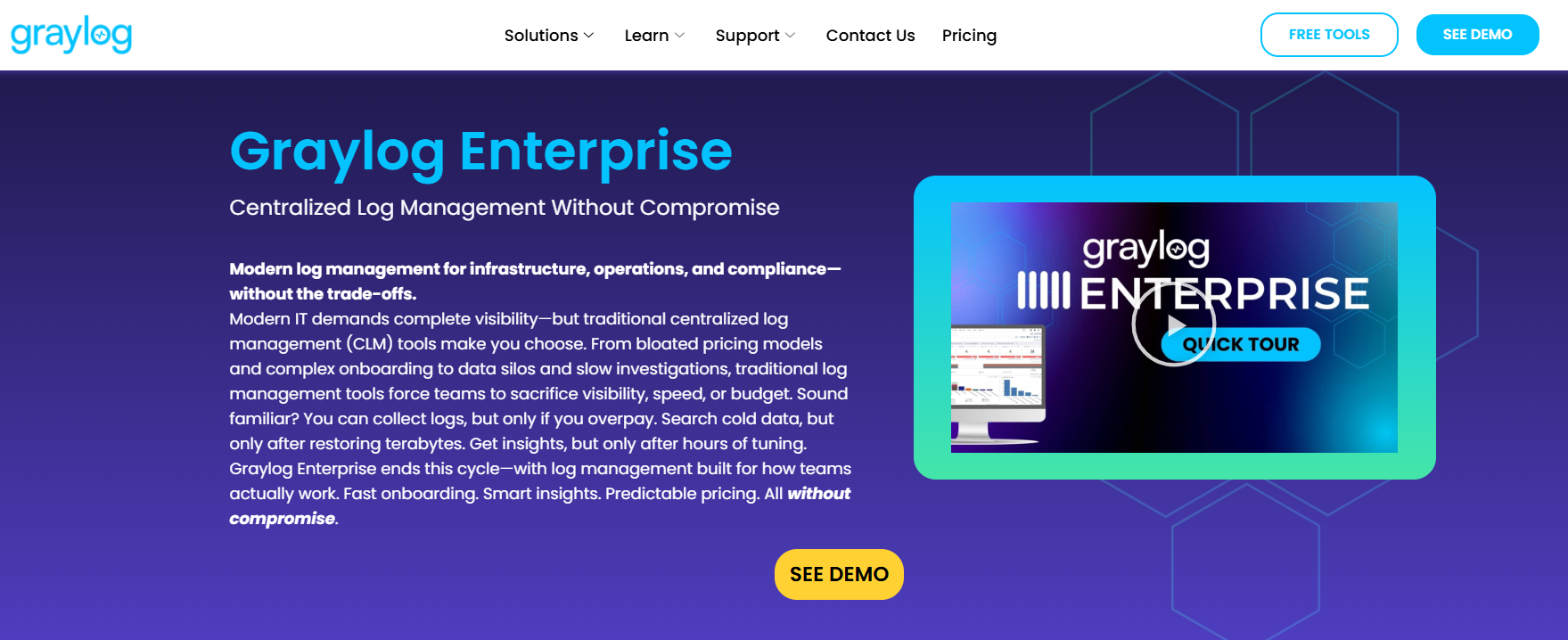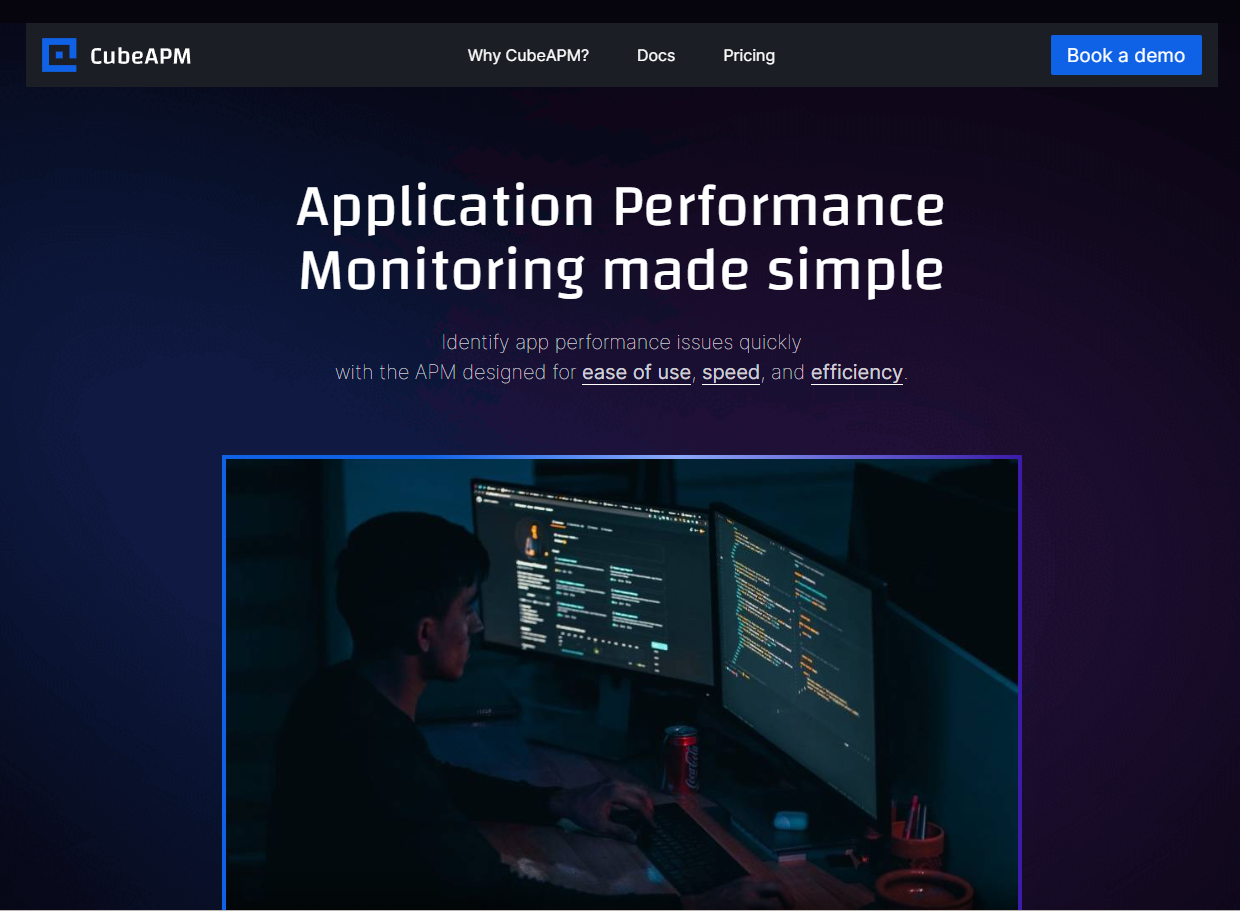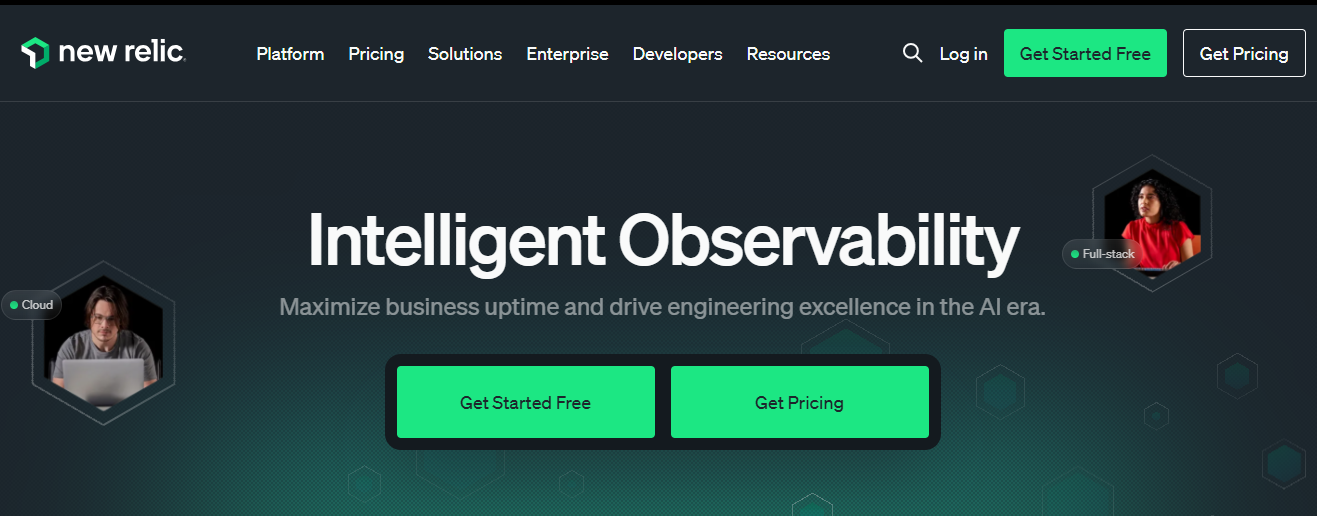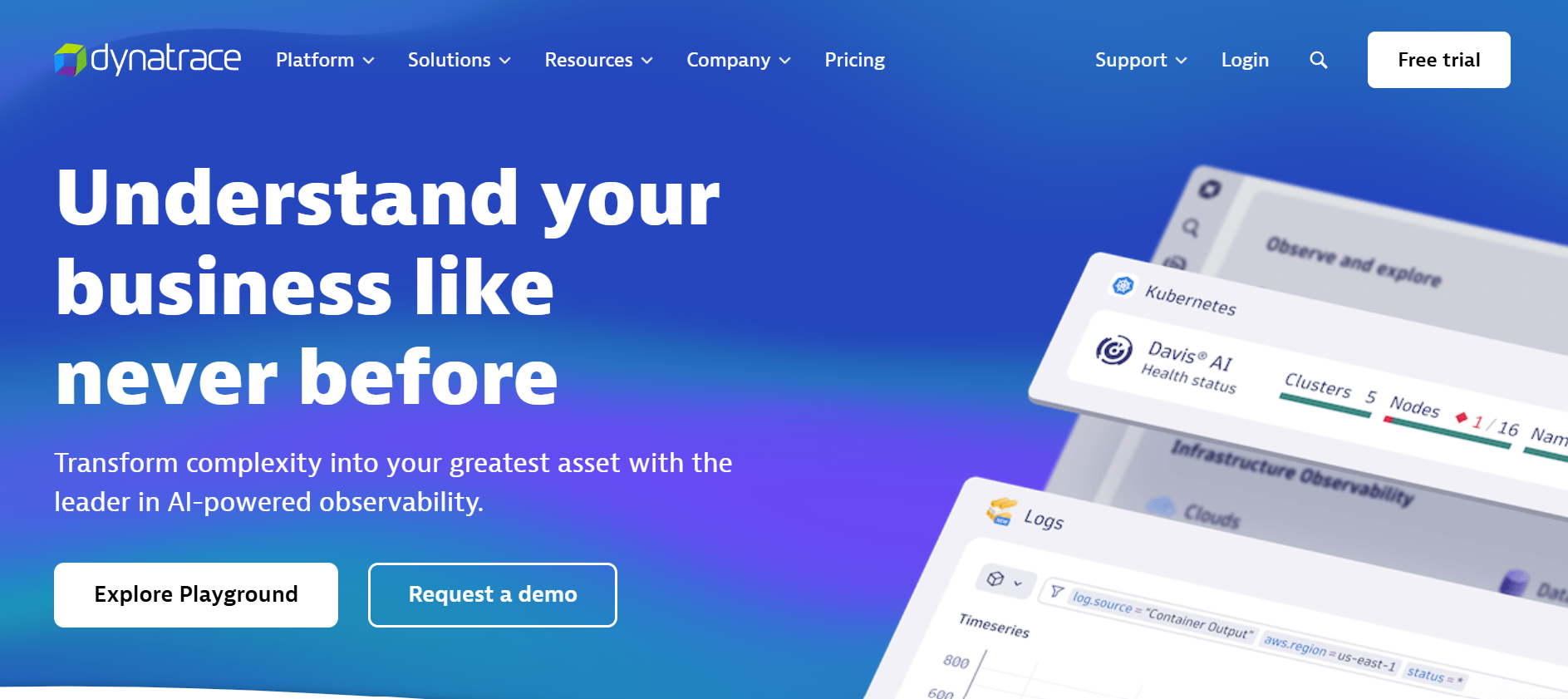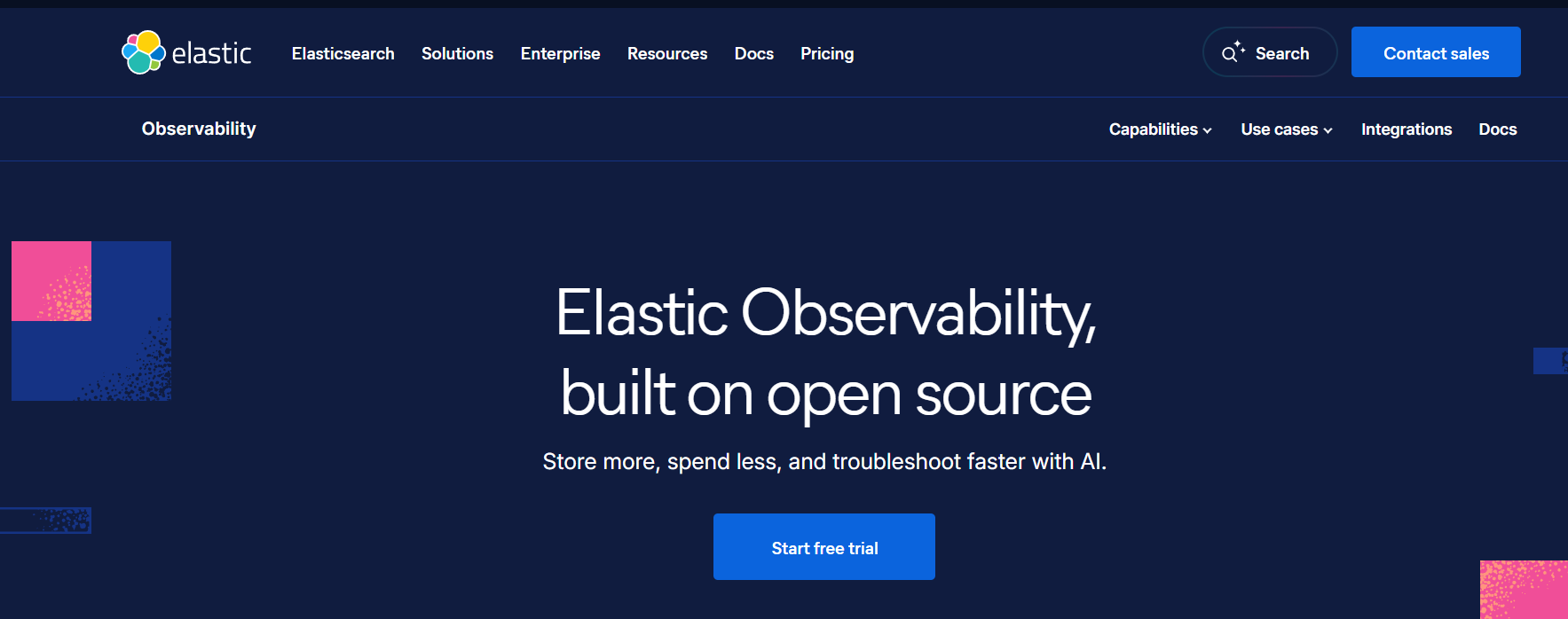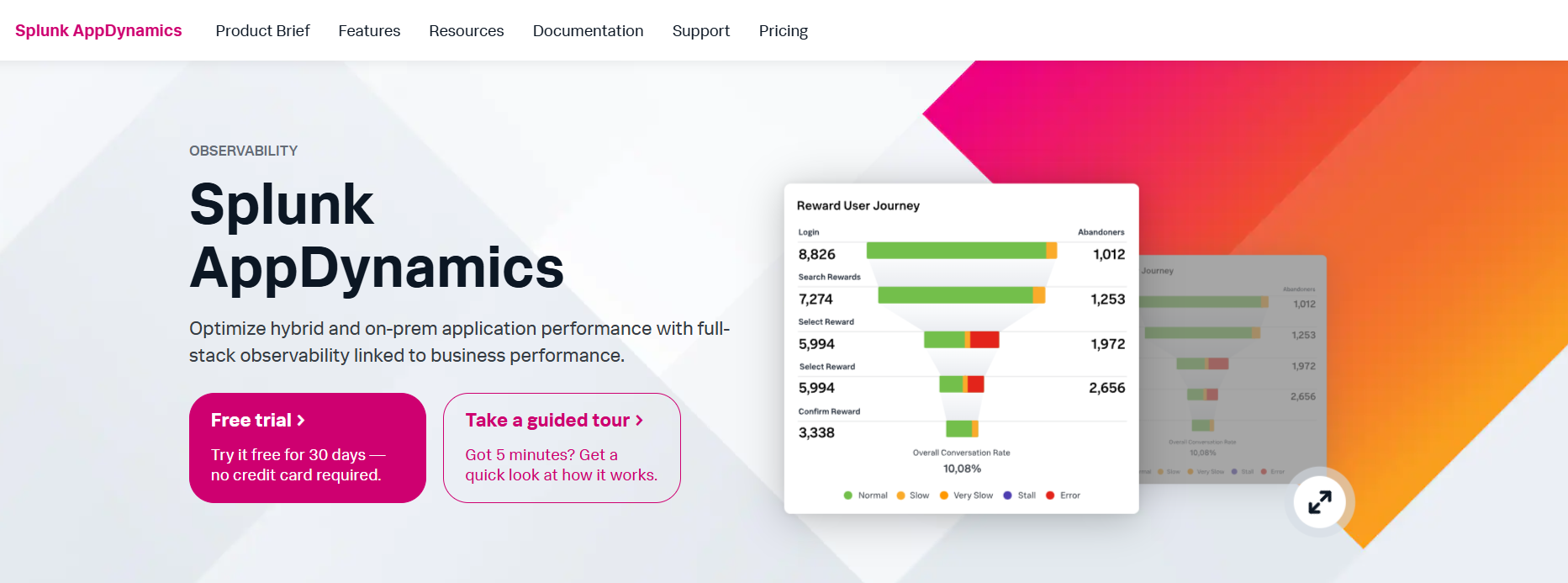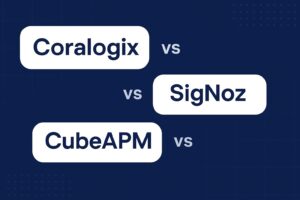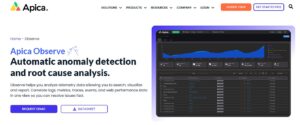Graylog is a popular open-source log management and SIEM tool with flexible pipelines and both free and paid editions. In a recent DevOps practitioner survey, 76% of organizations were found relying on open‑source observability tools like OpenTelemetry, underscoring a widespread shift toward richer, more flexible monitoring ecosystems.
However, Graylog tends to falter as systems scale—requiring deep infrastructure tuning for performance—and it lacks built-in support for traces, metrics, RUM, or synthetics. Worried teams end up juggling multiple tools and absorbing unpredictable license fees.
This is where CubeAPM shines—truly the best Graylog alternative—with MELT observability (logs, metrics, events, traces, RUM, synthetics), full OpenTelemetry support, smart sampling, transparent pricing, flexible deployment, and developer-friendly support.
In this article, we’ll explore the best Graylog alternatives, comparing them on observability breadth, deployment flexibility, pricing, and support.
Table of Contents
ToggleTop 7 Graylog Alternatives
- CubeAPM
- Datadog
- New Relic
- Dynatrace
- Elastic Observability
- Splunk Apdynamics
- Grafana Loki
Why People Are Looking for Graylog Alternatives
Scaling and Performance Challenges
On Reddit, one user mentioned using Graylog until ingest volumes reached 200 GB/day across a 6–8 node cluster—at which point even a simple 72-hour log search would crash the system unless nodes were beefed up extensively. This prompted them to migrate to Splunk for stability. Graylog users also have noted that Graylog Open (community edition) maintains all data in hot storage, lacking warm/cold tiers, which limits long-term retention flexibility without upgrading to the paid enterprise edition.
Dashboarding & Search Usability Issues
According to G2 reviews, users find Graylog’s dashboards difficult to navigate and the filtering options unintuitive. One reviewer noted: “creating dashboards and filtering of events is not the best for me,” pointing to usability friction—even in enterprise environments (G2).
Fragmented Observability Needs (Log-Only Focus)
While Graylog excels at log ingestion and centralization, teams increasingly need full MELT (metrics, events, logs, traces) support. Graylog doesn’t provide native tracing, RUM, or synthetic monitoring, causing teams to juggle multiple tools, which adds integration overhead and slows incident response. (This resonates from broader industry discussions and your previously shared context.)
Pricing Surprises & Costs at Higher Volume
Graylog Enterprise costs $15,000/year. Also, Security/API Security editions cost around $18,000/year. For organizations ingesting 10 TB per month (~120 TB/year), that can seem reasonable—but less obvious is the additional infrastructure cost (e.g., Elasticsearch, storage, redundant nodes), and the need to scale for performance adds to TCO.
Example
A mid‑size business with 10 TB monthly ingest might face significantly higher TCO due to cluster expansion, additional node licenses, and storage optimization.
Graylog Enterprise:
- Base license: $15,000/year, or ~$1,250/month.
- Infrastructure (assuming on-prem ES clusters, storage, ops team): difficult to estimate precisely, but generally much higher than CubeAPM’s $0.02/GB infra model. Especially as volume scales, retention performance requires more complex tiering and capacity.
But if you compare this to CubeAPM for the same data volume, it would cost you around $1,500/month.
Criteria for Suggesting Graylog Alternatives
Full MELT Coverage
Modern teams need more than just logs—complete visibility requires Metrics, Events, Logs, and Traces (MELT), plus RUM and synthetics for the user experience layer. Graylog is log-centric, so a good alternative must unify all signals to avoid siloed workflows. This makes troubleshooting faster by correlating a spike in latency with the exact log lines and spans that caused it.
OpenTelemetry-Native Ingestion
With OpenTelemetry (OTel) now the de facto industry standard, alternatives should support OTel agents out of the box. This helps you mitigate vendor lock-in issues. Instrument once and route telemetry to any backend seamlessly. Tools without strong OTel support risk leaving teams stuck with proprietary agents and higher migration costs.
Smart Sampling
High-volume telemetry can quickly become overwhelming and expensive. Platforms with adaptive or context-aware sampling retain traces tied to errors, slowdowns, or anomalies while filtering out noise. This strategy reduces ingestion costs by up to 70–80% while keeping critical diagnostic data intact—a major upgrade over storing everything blindly.
Deployment Flexibility
Compliance and cost control demand flexible options. Strong alternatives should allow self-hosting, hybrid setups, or Bring-Your-Own-Cloud (BYO-cloud) deployments. This ensures data residency for industries under GDPR/HIPAA and avoids egress-heavy SaaS models. Teams gain freedom to decide whether to run locally or on their preferred cloud infrastructure.
Transparent, Usage-Based Pricing
Opaque pricing is one of the biggest pain points with observability vendors. The best alternatives use flat, per-GB ingestion pricing without per-user or per-host add-ons. This makes costs predictable at scale—e.g., CubeAPM’s $0.18/GB total vs Datadog’s layered host, log indexing, and APM fees. Clear pricing prevents “bill shock” as data grows.
Tiered Retention and Fast Search
Efficient hot/warm/cold storage tiers let you keep recent data fast and cheap while archiving older logs affordably. Platforms that allow instant archive recalls or schema-on-read queries (like Dynatrace’s Grail or CubeAPM’s tiering) ensure performance doesn’t degrade at scale. This saves teams from the frustration of slow or failed queries during incidents.
Developer-Centric Support and Usability
Good observability isn’t just about features—it’s about how easy they are to use. Alternatives must offer intuitive dashboards, powerful filtering, and responsive support channels. Quick access to engineers (Slack, chat, or WhatsApp) and fast ticket turnaround times can make or break adoption, especially during outages.
Graylog Overview
Known for
Primarily recognized as a log management and SIEM platform designed for collecting, storing, indexing, and analyzing massive amounts of machine data. Graylog is especially valued for its strong open-source community roots and ability to handle structured and unstructured log data efficiently.
Standout Features
- Centralized Log Management: Aggregates logs from servers, containers, and applications into a single searchable interface.
- Security & Compliance Tools: Offers SIEM capabilities for monitoring security events, auditing, and regulatory compliance.
- Alerting & Monitoring: Built-in alert rules to notify teams when anomalies occur, with integrations into ops workflows like Slack or PagerDuty.
Key Features
- Custom pipelines: Before indexing, you can enrich, filter, and transform log data using custom processing rules.
- Extensible Architecture: Open plugin system and REST APIs that let teams extend Graylog with custom integrations.
- Data Management: Retention, archiving, and index lifecycle management for handling large-scale log data.
- Visualization & Dashboards: Interactive dashboards with widgets for monitoring trends, error spikes, and key log events.
- Open Source & Enterprise Editions: Source-available Graylog Open vs. licensed Enterprise and Security editions with advanced features.
Pros
- Strong open-source community and support for extensibility.
- Flexible log pipelines and data enrichment.
- SIEM capabilities make it appealing for security-conscious organizations.
- Free community edition is useful for smaller teams.
Cons
- Performance degradation at high ingest volumes without major infra tuning.
- Limited native support for metrics, traces, and RUM—logs-only focus.
- Dashboards and searches are often seen as unintuitive.
- Paid enterprise features can feel expensive compared to alternatives.
Best for
Graylog is best suited for teams that primarily need log aggregation, analysis, and security monitoring. It fits small-to-mid businesses that want a source-available platform with community backing, or enterprises that need SIEM compliance features. However, it is less ideal for organizations seeking full MELT observability or simplified cloud-native scalability.
Pricing & Customer Reviews
Graylog Enterprise pricing starts around $15,000/year, and the Security/API Security editions start from $18,000/year, billed annually. The open-source edition remains free, though scaling requires investment in infrastructure.
- G2 rating: 4.4/5
- Praised for: centralized log management, scalability for mid-tier workloads, and a strong community ecosystem.
- Criticized for: complex setup, weak dashboard usability, and lack of metrics/tracing support compared to modern observability suites.
Top 7 Graylog Alternatives
1. CubeAPM
Known for
CubeAPM is known as a modern, OpenTelemetry-native observability and APM platform built to deliver complete MELT (Metrics, Events, Logs, Traces) coverage in a single solution. Unlike traditional log-focused tools, it extends to real user monitoring, synthetics, infrastructure, and database visibility. It is particularly recognized for its cost transparency, 800+ ready integrations, and compliance-first deployment flexibility, making it a preferred choice for organizations handling sensitive data or scaling Kubernetes-heavy workloads.
Standout Features
- Smart Sampling Engine: Retains error- and latency-rich traces while filtering noise, cutting ingestion volume by up to 80%.
- Self-Hosting & BYO Cloud: Gives teams control over data residency for compliance (GDPR, HIPAA, DPDP) and cost efficiency.
- Slack/WhatsApp Support: Direct engineer-to-engineer assistance with response times measured in minutes.
Key Features
- Unified MELT Observability: Logs, metrics, traces, RUM, synthetics, error tracking, and infra monitoring all in one platform.
- OpenTelemetry-Native: No proprietary agents—teams can instrument once and route anywhere.
- Transparent Pricing: Starts at $0.15/GB ingestion, with no per-user or host charges.
- No Egress Costs: Self-hosting and BYO-cloud deployment eliminate data egress penalties common in SaaS platforms.
- 800+ Integrations: Prebuilt integrations with databases, cloud providers, and developer tools for rapid adoption.
- Database & Kubernetes Monitoring: Deep integrations for MySQL, PostgreSQL, and K8s workloads with auto-discovery.
- Real User & Synthetic Monitoring: Tracks user journeys and simulates requests for proactive incident detection.
Pros
- Predictable usage-based pricing with no hidden fees
- OpenTelemetry-native ingestion reduces vendor lock-in
- Covers the full MELT stack in one product
- Flexible deployment models (SaaS, self-hosted, BYO cloud)
- Excellent developer-focused support with fast TAT
Cons
- Not suitable for users looking for SaaS-only platforms
- An observability platform only, with no support for cloud security management features
Best for
CubeAPM is the best option for organizations that are looking for a platform that can provide end-to-end observability at an affordable and predictable cost. Particularly, mid-to-large businesses that regularly ingest high data volumes, and those that are compliance-sensitive and require a data residency option will benefit a lot from CubeAPM.
Pricing & Customer Reviews
- Pricing: $0.15/GB all-in (ingestion + infra + transfer)
- Score: 4.7/5
- Praised for: transparent plus affordable pricing, OTEL native, and faster support via Slack
CubeAPM vs Graylog
Graylog focuses more on logs and SIEM, but CubeAPM is a complete observability platform. It offers full MELT, OpenTelemetry support natively, intelligent sampling, transparent pricing, no egress costs, and 800+ integrations. Graylog’s enterprise license starts at $15K/year plus infra overhead, but CubeAPM’s pricing is straightforward with ingestion-based pricing of $0.15/GB. It saves around 60–80% of costs for mid-sized companies.
2. Datadog
Known for
Datadog is widely recognized as a full-stack monitoring and observability platform that brings together infrastructure, APM, logs, security, and user experience monitoring in one SaaS offering. It is especially popular among large-scale cloud-native environments thanks to its 850+ out-of-the-box integrations with AWS, Azure, GCP, and developer tools.
Standout Features
- Unified SaaS Platform: Combines APM, logs, metrics, RUM, synthetics, and security monitoring in one place.
- High-Cardinality Analytics: Teams can slice and dice billions of data points for granular insights.
- Massive Integrations Library: 850+ integrations covering databases, containers, CI/CD pipelines, and more.
Key Features
- Distributed Tracing: Visualize service dependencies and latency bottlenecks across microservices.
- Infrastructure Monitoring: Tracks CPU, memory, disk, and containerized workloads with auto-discovery.
- Log monitoring: The tool collects, analyzes, and indexes your logs and applies live tailing and archiving.
- Real User & Synthetic Monitoring: Test real-world experiences and proactively detect broken endpoints.
- Cloud Security Monitoring: Detect threats and misconfigurations alongside observability data.
- Dashboards & Alerts: Prebuilt dashboards and anomaly detection for real-time alerting.
Pros
- Comprehensive monitoring across infra, APM, logs, and security
- 850+ integrations make it easy to adopt in multi-cloud environments
- Strong visualization tools with real-time dashboards
- Scales well for enterprise workloads
Cons
- Pricing is complex with multiple SKUs and hidden cost levers
- High-water mark billing for hosts increases unpredictability
- Separate ingest and index pricing for logs leads to double-charging
- Steep learning curve for new users due to platform breadth
Best for
Datadog is best for enterprises and scale-ups that want a broad SaaS-based observability suite with security features included, and have the budget to absorb higher costs. It’s most effective in cloud-native, container-heavy, and multi-cloud ecosystems that benefit from its integration library and visualization depth.
Pricing & Customer Reviews
- Pricing: APM: $31/host/month, logs: $0.1/GB, Infra: $15/host/month
- G2 rating: 4.4/5
- Praised for: breadth of features, massive integrations, and reliable SaaS scalability
- Criticized for: opaque pricing, billing unpredictability, and steep learning curve
Datadog vs Graylog
While Graylog is primarily a log management and SIEM tool, Datadog offers comprehensive SaaS-based observability with metrics, traces, RUM, and security features. However, Datadog’s pricing complexity (double-charging logs) makes it significantly more expensive at scale compared to Graylog. Teams moving from Graylog to Datadog often do so for full-stack visibility, but must prepare for a sharp rise in costs.
3. New Relic
Known for
New Relic stands out as a unified, AI-enhanced observability platform that spans the full telemetry spectrum—metrics, logs, traces, and events—while also offering synthetics, real-user monitoring, infrastructure visibility, and security insights. It’s particularly well-known for its deep AI-powered insights, extensive integration ecosystem, and its ability to scale across complex cloud and multi-stack environments. Its “single pane of glass” experience empowers engineering teams to bridge data silos and troubleshoot with contextual intelligence.
Standout Features
- Agentic AI Engine: Leverages AI/LLMs to interpret dashboards, auto-generate alerts, and help troubleshoot issues in human language.
- 780+ Integrations: Offers one of the largest quick-start integration libraries, enabling easy connection across cloud and tools.
- All-in-One Platform: Combines observability, application monitoring, infrastructure, synthetics, and security into a unified UX.
Key Features
- Distributed Tracing & APM: End-to-end visibility into service dependencies and transaction performance.
- Real User & Synthetic Monitoring: Captures user journey and simulates behavior to detect regressions early.
- Infrastructure & Cloud Insights: Automatically monitors hosts, containers, network, DBs, and Prometheus-compatible systems.
- Error Tracking & Alerts: Centralized error inbox and customizable alerts with contextual insights for faster triage.
- OTel support: The tool takes OTel data natively to simplify your instrumentation process and is also compatible with multiple tools.
- Dashboards & Change Tracking: Custom dashboards with anomaly detection and visual change overlays for observability clarity.
Pros
- Comprehensive observability across MELT and more
- Massive integration library simplifies rollout
- AI-powered insights reduce troubleshooting time
- Scales seamlessly across enterprise environments
Cons
- Can be overwhelming due to the many features
- Some users report slower or templated support experiences
Best for
New Relic is a strong match for digital-first enterprises seeking an AI-powered, all-in-one SaaS observability suite. Particularly suited for organizations that want to unify performance, infrastructure, and user-experience metrics under one roof with scalable AI tools and deep integrations—but are comfortable navigating a feature-rich environment.
Pricing & Customer Reviews
- Free: You get up to 100 GB/month of data you ingest, 1 user
- Ingestion-based: $0.35/GB + $418/user/month for full access
- G2 rating: 4.4/5
- Praised for: unified full-stack observability, AI-powered troubleshooting, and integration breadth
- Criticized for: steep learning curve and slower support responsiveness
New Relic vs Graylog
While Graylog specializes in log aggregation and basic SIEM, New Relic delivers rich, AI-enhanced MELT observability, synthetics, and security—all in a cohesive SaaS offering. It caters to teams who want advanced telemetry and predictive insights out of the box, though this comes with greater complexity and potentially higher costs than Graylog’s simpler, log-first model.
4. Dynatrace
Known for
Dynatrace is recognized as an enterprise-grade, AI-powered observability and security platform that delivers comprehensive visibility across applications, infrastructure, user experience, and threat environments. Its OneAgent automatically discovers and maps dependencies in real time, while its Davis AI engine conducts intelligent root-cause analysis and anomaly detection—making it a go-to choice for teams operating complex, multicloud, and hybrid environments.
Standout Features
- Davis AI Engine: Automates detection of anomalies and root-cause insights with causal reasoning, alerting teams to what happened and why
- Automatic Discovery & Topology Mapping: OneAgent continuously instruments services and infrastructure to build live dependency maps
- AI-Powered Security Integration: Embeds real-time vulnerability and threat detection within the observability context, bridging security and performance
Key Features
- Full-Stack APM & Observability: Captures metrics, logs, traces, and events across apps, infra, cloud, and user experience (RUM and synthetic)
- Real-User & Synthetic Monitoring: Monitors actual user journeys and simulates traffic for proactive performance checks
- Grail Data Lakehouse: Schema-on-read data storage offering high-scale analytics without upfront indexing
- OpenTelemetry Support: Ingests OTel-native data for flexible instrumentation and migration paths
- Infrastructure & Cloud Monitoring: Supports hosts, containers, and orchestration platforms (AWS, Azure, GCP, Kubernetes) with auto instrumentation
Pros
- Automates RCA across different dependencies
- OneAgent streamlines deployment with minimal configuration
- Unified observability and security visibility in one platform
- Scales robustly across large, dynamic environments
Cons
- Expensive for smaller teams due to a premium, usage-based pricing model
- Difficult to learn and use for new users because of the overflowing features
Best for
Dynatrace is a great option for larger businesses that have complex IT environments and are looking for an AI + observability + security in one tool. Ideal when you want automated instrumentation, topological context, real-time causal analysis, and threat observability—but are prepared to invest in a rich, high-end solution.
Pricing & Customer Reviews
- Pricing: usage-based pricing model; costs $0.08/hour/8 GB host for full-stack Monitoring. Infrastructure and K8 monitoring, RUM, security, and log ingestion cost extra.
- G2 rating: 4.5/5
- Praised for: AI-powered root cause insights, automatic discovery, comprehensive observability
- Criticized for: high cost and a challenging learning curve
Dynatrace vs Graylog
Graylog is focused on log aggregation and compliance-oriented SIEM use cases, whereas Dynatrace provides end-to-end AI-enhanced observability and embedded security detection across the stack. In return for higher cost and complexity, Dynatrace delivers significantly greater automation, context, and scale—making it a powerful upgrade for enterprises transitioning from siloed log management to autonomous observability.
5. Elastic Observability
Known for
Elastic Observability offers a solid observability solution built on top of Elastic Stack. It lets you ingest, search, and analyze logs, metrics, traces, user experience data, and synthetics. It leverages the power of Elasticsearch and Kibana to consolidate telemetry with reliable scalability and advanced search capabilities across hybrid and cloud-native environments.
Standout Features
- ELK-Based Architecture: Combines Elasticsearch, Logstash/Beats, and Kibana for deep search and analytics.
- AI-Powered Insights: Includes anomaly detection and AI-based assistance to help identify issues swiftly.
- Universal Telemetry Ingestion: Handles logs, metrics, traces, RUM, synthetics, and profiling in a unified workflow.
Key Features
- Multi-Signal Observability: Supports logs, infrastructure metrics, APM, real user monitoring, synthetics, and profiling under one roof.
- Instant Search & Visualization: Allows real-time log queries via Discover, visualized through Kibana dashboards and charts.
- Machine Learning & AIOps: Auto-detects anomalies and helps pinpoint root causes with built-in analytics.
- Service-Level Objectives & Alerting: Create SLOs and receive triggered notifications across multiple channels.
- OpenTelemetry Support: Accepts OTel-formatted telemetry natively for consistent data pipelines.
- Scalable Data Platform: Designed for petabyte-scale storage and fast retrieval with schema-less indexing.
Pros
- Strong search and log correlation built on ELK
- Open-source roots and extensibility
- Broad telemetry support and AI-driven analytics
- Scalable architecture for large data volumes
Cons
- Setup and optimization can demand deep expertise
- Infrastructure and maintenance costs can climb without careful tuning
Best for
Elastic Observability is ideal for teams that already use—or want—the ELK Stack to power in-house, scalable observability with search-based analysis and AI-enhanced insights. It suits organizations with heavy telemetry volumes that need flexible queries and visualization but have resources to manage infrastructure.
Pricing & Customer Reviews
- Hosted: ranges $99-184/month
- Serverless (ingestion-based): $0.15/GB
- Synthetic monitoring: $0.0123/test run
- G2 rating: 4.2/5
- Praised for: strong search-driven observability, flexible visualizations, and ELK extensibility
- Criticized for: steep learning curve and managing resource overhead in large deployments
Elastic Observability vs Graylog
Compared to Graylog—primarily a log aggregator and SIEM—Elastic Observability delivers broad-stack observability, search-optimized querying, AI-powered insights, and petabyte-scale scalability. Yet, mastering its richness requires more infrastructure investment and operational know-how, making it a powerful, albeit heavier, upgrade from Graylog.
6. Splunk AppDynamics
Known for
Splunk’s observability suite is renowned for delivering enterprise-grade, end-to-end performance and business visibility, combining AppDynamics with the broader Splunk Observability Cloud. It tracks application, infrastructure, and digital experience metrics in real time, tightly linking operational performance with business outcomes across hybrid, on-prem, and cloud environments.
Standout Features
- Business-Impact Analytics: Correlates application performance problems with revenue, conversion, and other business KPIs.
- AI-Enabled Root Cause & Anomaly Detection: Uses ML-driven baselining to surface issues and their underlying causes proactively.
- Unified Context Across Tools: Deep linking between AppDynamics and Splunk logs ensures smooth traversal from application faults to their log-based root cause—all within one platform.
Key Features
- Full-Stack Observability: Monitors applications, infrastructure, real-user and synthetic journeys, along with logs and error tracing.
- Native Otel: Simplifies the instrumentation process for teams while mitigating the chances of vendor lock-ins.
- Synthetic & Digital Experience Monitoring: Tracks end-user journeys across web, mobile, and APIs for proactive performance insights.
- Network & SAP Monitoring: Covers third-party APIs, ISPs, SAP systems, and infrastructure flows with transaction-level diagnostics.
- Smart Agent Automation: Auto-discovers and instruments applications with minimal effort, accelerating deployment at scale.
- Log Context Integration: Log Observer Connect allows logs to surface in context from AppDynamics views, enriching troubleshooting workflows.
Pros
- Rich, business-centric observability across every layer
- AI/ML-powered anomaly detection and root cause analysis
- Mature enterprise-grade infrastructure and adaptation to hybrid stacks
Cons
- Expensive for mid-sized teams due to premium pricing and feature breadth
- Complexity and setup overhead can be high for non-enterprise environments
Best for
Splunk’s observability suite is best for large-scale enterprises seeking integrated app, infra, digital experience, and log observability, particularly when business impact, troubleshooting efficiency, and enterprise security context are top priorities. It suits organizations needing mature tooling for multi-tier and hybrid systems.
Pricing & Customer Reviews
- Price: Starts at $6/month to $50/host/month, billed annually
- G2 rating: 4.3/5
- Praised for: Observability with business alignment, strong AI/ML
- Criticized for: steep pricing and operational complexity
Splunk vs Graylog
Compared to Graylog’s log-centric approach, Splunk’s observability portfolio delivers AI-enabled full-stack observability, business KPI correlation, and tight integration across AppDynamics and Splunk Platform. However, this comes with a higher cost and complexity, making Splunk a heavyweight enterprise solution versus Graylog’s simpler log-first model.
7. Grafana
Known for
Grafana is celebrated as an open, composable observability and data visualization platform that pulls together metrics, logs, and traces from virtually any source—ranging from Prometheus and Loki to Graphite and Elasticsearch. Strongly rooted in open-source, it empowers teams to build custom, interactive dashboards and alerting systems, whether run in Grafana Cloud or deployed self-hosted via Grafana Enterprise. Its plugin ecosystem and unified visualization layer make it a go-to for democratizing telemetry across teams.
Standout Features
- Composable Architecture: Enables visualizing metrics, logs, and traces from diverse data sources without locking into ingestion pipelines.
- Observability-as-Code (Grafana 12): Supports versioning and automation of dashboards and resources—ideal for GitOps-aligned workflows.
- Turnkey LGTM+ Stack: Grafana Cloud natively integrates Loki (logs), Mimir (metrics), Tempo (tracing), plus alerting and SLO management, offering a fully managed observability stack.
Key Features
- Flexible Dashboarding: Create rich, shareable dashboards with drag-and-drop panels for real-time insights.
- Query & Alerting Flexibility: Visualize data on the fly and define threshold- or anomaly-based alerts across sources.
- Plugin Ecosystem: Tap into hundreds of official and community plugins for extended data source and visualization support.
- Enterprise Collaboration Tools: Share dashboards across teams, view usage insights, and export reports in PDF (Enterprise).
- Free-to-Start Tier: Grafana Cloud offers a meaningful free plan—50 GB logs, metrics, traces, plus profiling—great for fast prototyping and trial.
Pros
- Unmatched visualization flexibility and data source agnosticism
- OpenTelemetry-friendly and rich plugin ecosystem
- Observability-as-code simplifies collaboration and version control
- Generous free tier to get started without friction
Cons
- Not an all-in-one observability provider—requires assembly of MELT stack components
- May demand more ops effort to scale and optimize compared to integrated platforms
Best for
Grafana fits teams that prioritize flexible visualization, open-source tooling, and composability—especially those already invested in Elastic, Prometheus, or cloud-native stacks. Ideal for organizations wanting highly customizable dashboards and automation-first workflows, without vendor lock-in.
Pricing & Customer Reviews
- A free tier with 50 GB logs, traces, and profiles, plus 10k metrics and 14-day retention.
- Pro (Pay-as-you-go): Starts at $19/month
- Enterprise pricing is custom
- G2 rating: 4.5/5
- Praised for: flexibility, visualization quality, and community-driven ecosystem
- Criticized for: rudimentary alerting features and more manual integration setup
Grafana vs Graylog
Unlike Graylog’s log-first, SIEM-focused model, Grafana excels as a visualization-powered observability toolbox—uniting telemetry from multiple sources into dynamic dashboards. While it doesn’t ship MELT components out of the box, its flexibility and open architecture make it an excellent complement or alternative when visualization and customization are top priorities.
Conclusion
Graylog is undeniably useful for log management and SIEM, but it struggles with performance at scale, limited MELT coverage, complex dashboards, and expensive enterprise licensing. These gaps leave many teams seeking more complete, cost-efficient observability solutions.
CubeAPM is the best Graylog alternative, delivering full MELT observability, OpenTelemetry-native ingestion, smart sampling, 800+ integrations, no egress fees, and flexible self-hosting/BYO-cloud deployment—all at transparent $0.15/GB pricing.
If you’re ready to move beyond log-only monitoring, start with CubeAPM today and modernize your observability with confidence.

